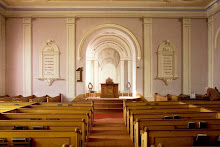
READFIELD -- The historic Readfield Union meeting House this week completed the first step of a multi-year project to preserve and restore its rare and beautiful windows. Thanks from a grant from The National Historic Preservation Commission in Boston the exterior casings of the five most endangered windows were scraped, primed and painted and then covered with clear UV-resistant Lexan sheets. The work was done by a master craftsman, Joseph Caputo of East Pittston who is knowledgeable about historic buildings.
The Brick Church has 17 windows, the majority of which have not been painted and cared for in over 140 years. Some contain unusual colorful non-leaded stenciled glass panes while others are of more traditional stained glass of the Arts and Crafts era. The stenciled glass windows are most unusual, with only one other church in Maine have examples of this uusual mid-19th centiry craftsmanship. They were installed when the Meeting House was remodeled in 1866-68.
The National Trust Emergency Intervention Fund paid for half of the total cost, with the remainder coming from income the Meeting House received this year from its initial membership drive. "With restoration expected to reach into the six figures, the Meeting House Board wishes to recognize the kindness of both new members and the National Trust for making this advance possible," said Meeting House Board President Marius B. Peladeau of Readfield.
For the current project the casings were carefully scraped to the bare wood. Samples were taken of the original paint so that it could be matched exactly. New primer and paint was applied. The Lexan was then carefully cut to fit into the arched window opening. Two sheets had to be used so that a horizontal rail could be placed at the middle to mimic the meeting rail of the two original sashes. Before the Lexan was screwed on spacers were placed around the casing so that the plastic sheets do not rest directly on the casing. This will allow condensation, which will form when sun strikes the cold Lexan, to dissapate through weep holes at the top and bottom.
To make the installation as unobtrusive as possible the round molding which forms a visual transition between the casing and brick wall was also allowed to show so that the original architect's intentions have not been violated. In all, three windows in the facade and two in the apse were completed this fall.
"Now that the windows are closed in from the weather with the Lexan, the Board will now try to raise funds so that the badly deteriorated sashes can be taken out from the inside and removed to a restorer's workshop this winter to be rebuilt, painted and reglazed," Peladeau added. Most of the large windows will cost up to a $1,000 to rehabilitate, but some of the smaller sashes can be restored for $300 to $400. Anyone willing to "adopt" a window should contact the Meeting House at 685-4537.








